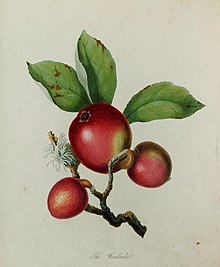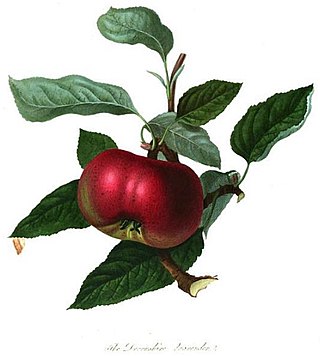| 'Woodcock' | |
|---|---|
 | |
| Species | Malus domestica |
| Origin | |
The Woodcock was one of the oldest described English varieties of cider apple. It originated in the West of England in the counties of Herefordshire and Gloucestershire.
| 'Woodcock' | |
|---|---|
 | |
| Species | Malus domestica |
| Origin | |
The Woodcock was one of the oldest described English varieties of cider apple. It originated in the West of England in the counties of Herefordshire and Gloucestershire.
Hogg described the apple as medium-sized, oval, with a distinctive fleshy, curved stalk of about three-quarters of an inch in length: the skin was yellow with a soft red flush, deeper on the sunward side. [1] The tree itself was large and vigorous, forming large branches in the manner of a pear tree. [2]
The varieties' name was popularly supposed to refer to the stalk's resemblance to the head of a woodcock; but Thomas Andrew Knight, who described and illustrated the apple in his Pomona Herefordiensis, surmised that its name was originally that of the person who first raised the variety. [1] In Welsh the Woodcock was known as afal coes y dryw or afal coeshir y gwin, both names referring to the fruit's distinctive stem. [3]
The Woodcock was noted by writers as far back as the 17th century, making it one of the earliest described varieties. John Evelyn described it as one of the principal "Gloucestershire cider-fruit" in his work Sylva . [4] John Philips, in Book 2 of his poem Cyder (1708), described how juice of the Woodcock was blended with that of other apples to create "a pleasurable Medly".
By the 19th century the variety was said to be in decline and little planted. [5] The Somerset grower John Scott (1807–86) noted that it was still in existence in the late 19th century, describing it as a "beautiful light red apple". [6] The variety is now thought to be lost, though a correspondent to The Gardeners' Chronicle, writing in 1932, stated that after "long hunting and enquiry about the orchards" they thought that the Monmouthshire variety "Frederick" was closely related or identical to the old Woodcock. [7]
Perry or pear cider is an alcoholic beverage made from fermented pears, traditionally in England ; parts of South Wales; France ; Canada; Australia; and New Zealand. There is growing interest in artisinal perry production in the fruit-growing regions of the northwest United States.

Cider apples are a group of apple cultivars grown for their use in the production of cider. Cider apples are distinguished from "cookers" and "eaters", or dessert apples, by their bitterness or dryness of flavour, qualities which make the fruit unpalatable but can be useful in cidermaking. Some apples are considered to occupy more than one category.

The damson or damson plum, also archaically called the "damascene", is an edible drupaceous fruit, a subspecies of the plum tree. Varieties of insititia are found across Europe, but the name damson is derived from and most commonly applied to forms that are native to Great Britain. Damsons are relatively small ovoid plum-like fruit with a distinctive, somewhat astringent taste, and are widely used for culinary purposes, particularly in fruit preserves and jams.

The 'Roxbury Russet' is an apple cultivar, believed to be the oldest apple cultivar bred in the United States, having first been discovered and named in the mid-17th century in the former Town of Roxbury, part of the Massachusetts Bay Colony southwest of Boston. It is known by several other names including 'Boston Russet', 'Putnam Russet', and 'Sylvan Russet'.

The Kingston Black, also known as Black Taunton, is a cultivar of apple originating from the United Kingdom and used in making cider. The name of the cultivar comes from the apples' dark red or purplish skin, though despite the name, the fruit does not have a black hue.
'Brown Snout' is a 19th-century cultivar of cider apple originating in Herefordshire in the United Kingdom, though now grown in other counties and parts of the world.

The Foxwhelp is a very old cider apple cultivar, originating in the west Midlands of England.

The Styre or Stire, also known as the Forest Styre, was an old English variety of cider apple which was formerly common in the Forest of Dean. It is currently thought to be extinct, but may still survive in old orchards or gardens.

The Harrison cider apple is one of the most famous 18th-century American cider apples, primarily used for the production of apple cider. Grown in New Jersey before and after the American Revolution, it fell out of favor by 20th century. The Harrison cider apple was considered lost until it was recovered in Livingston, New Jersey at an old cider mill in September 1976.

The Redstreak, also spelt Redstrake, Red Streak or Red-streak, is or was a very old variety of cider apple formerly commonly planted in England.
Cider in the United Kingdom is widely available at pubs, off licences, and shops. It has been made in regions of the country where cider apples were grown since Roman times; in those regions it is intertwined with local culture, particularly in the West Country.
The Cambrian Journal contains a list of names for about 200 Welsh apples, the majority of which were from the Monmouth area.

Slack-ma-Girdle is an old variety of cider apple formerly widely grown in the South-West of England. It is one of a group of similar and closely related varieties all often known by the name "Woodbine".
The 'Chisel Jersey' is a cultivar of cider apple originating in Somerset.
The Coccagee, also spelt 'Cackagee' or 'Cockagee' and sometimes known as the 'Irish Crab' or 'Lord Cork's Crab', is or was a variety of cider apple, known in Ireland and the West of England.
Major is a cider apple cultivar first grown in the United Kingdom in the area of Devon and Somerset.

The cuisine of Monmouthshire is historically associated with Lady Augusta Hall, also known as Lady Llanover, who published one of the first Welsh cookery books, First Principles of Good Cookery (1867). The book uses a fictional Welsh hermit to give culinary advice to a visiting guest who is travelling though Wales.
The costard was a variety of apple popular in medieval England, and the second apple-variety introduced by the Normans. It was grown widely as a commercial crop by the 13th century and was supplied to the household of Edward I in 1292. It remained widespread for several hundred years, until other apple varieties gained popularity during the 17th century. It is thought to have been a cooking apple and was perhaps similar to the modern Bellflower apple. It is said to have been named for its resemblance to the human head.
The Poveshon, sometimes "Povershon", is an 18th-century American cider apple, primarily used for the production of apple cider. Grown in New Jersey before and after the American Revolution, it became obsolete by the 20th century as the cider industry in the state declined. It is considered lost, though it has possibly been rediscovered.

The Devonshire Quarrenden is a dessert apple cultivar historically grown and probably originating in England, although it has also been suggested as originating in France. A variety of local names and spellings, including "Red Quarrenden", "Quarrington", "Quarender", and the "Sack Apple", have been recorded in the past.